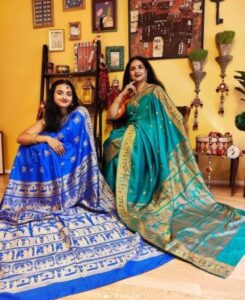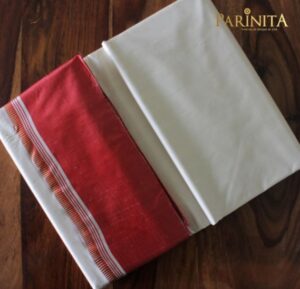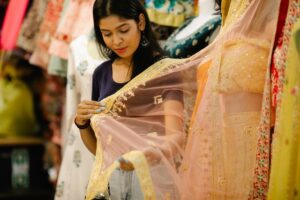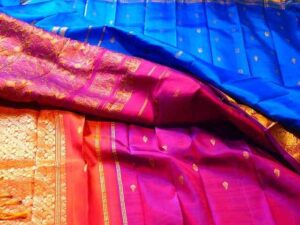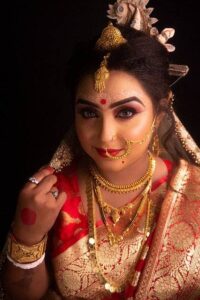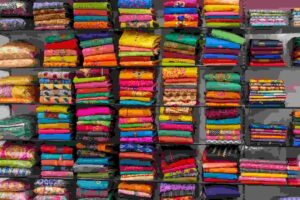Handloom saree weaving in Bengal can be traced back to the 15th century in Shantipur, West Bengal. The art flourished under the Mughal patronage. The royal class adorned the fine Muslin, Jamdani, and general people preferred Tant.
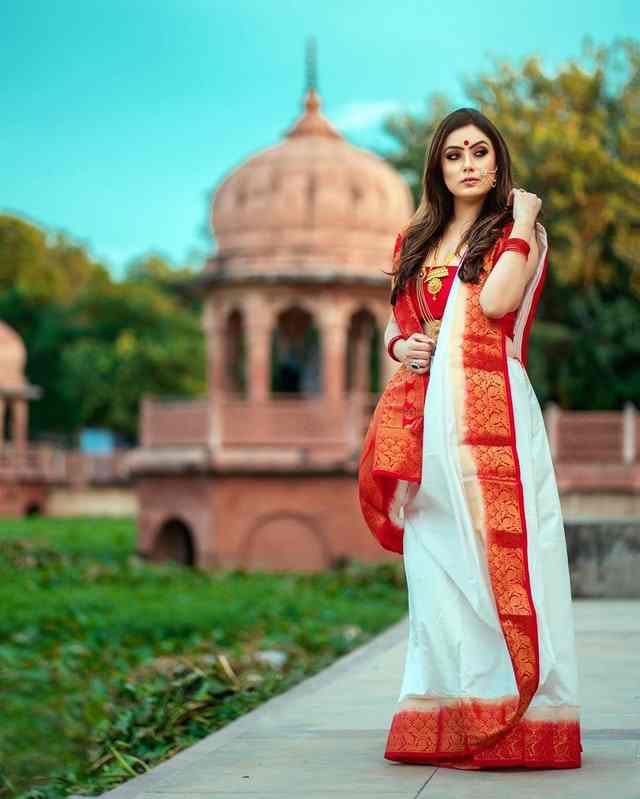
In the 18th century, the Mughal Governor of Bengal, Nawab Murshid Quli Khan, shifted his capital to Murshidabad from Dhaka. Many weavers accompanied him. The Nawab settled them in the neighboring towns of Murshidabad.
The British wanted to prosper the European textile industry. British tried hard to destroy the weaving form of Bengal, but somehow it managed to survive.
During the partition of India in 1947, many Hindu artisans from Bangladesh immigrated to India. They settled in the different parts of West Bengal, mostly in the Hooghly and Burdwan districts. Over the years, weavers from these regions have developed their style and produce the best quality sarees.
This article explains the unique qualities and history of the sarees of the Bengal region. Also, the occasion on which Bengali women love to drape them.
Types Of Bengali Sarees
1. Bengali Tant Saree

A Bengali woman’s wardrobe is incomplete without a Tant saree. This lightweight translucent saree has its origin in Bengal. Cotton thread used in the saree makes it ideal for the hot and humid climate conditions of the Bengal region.
2. Bengali Batik Print Saree

Batik is an age-old Indonesian dyeing technique using wax. This exquisite art of Batik enthralled Rabindranath Tagore during his travel to Java in Indonesia.
3. Jamdani Saree
This saree is the most famous among Bengali women. Dhaka, Bangladesh, is the birthplace of this exquisite saree fabric. Jamdani, a Persian word, is a mix of two terms, Jam means a flower, and Dani, meaning a vase. As the name refers, the Jamdani saree has beautiful floral patterns across the length of the saree.
This art form bloomed during the Mughal period, and different Persian themes such as buttis, jewels, emeralds grace the saree.
At present times, different regions of West Bengal and Bangladesh produce Jamdani sarees. These sarees are famous after that area, for example, the Tangail Jamdani, Dhanekhali Jamdani saree, Shantipur Jamdani, and the Dhakai Jamdani.
Dhakai Jamdani from Bangladesh is the original and the finest sarees with the most elaborate craft. Women wear it to festive occasions.
4. Garad Saree
The quintessential Garad saree has its inception in West Bengal and mainly produced in the Murshidabad region. It is the emblem of Bengali culture and tradition. The word Garad signifies White in Bengali. The red border on a pure white body and paisley, floral motifs are the main features of this Bengali saree. The texture of the saree resembles tissue paper. This lightweight saree is easy to carry.
In ancient times, kings and zamindars of Bengal used to wrap themselves in Garod cloth to perform religious rituals. Well, they have their reasons.
No artificial dye is used in the famous Garod saree. Thus, make it suitable for wearing to auspicious occasions such as a puja or religious ceremony. Bengali women do not stitch a fall in Garod sarees to preserve its pure form and wear it during Durga Puja.
5. Korial Saree
Korial means spotless. It is quite similar to the Garad saree. As the name suggests, It is a crisp white saree with a red border. The difference is that the Korial saree border is bright red. Lal Paar saree is another name of Korial Saree.
Mostly, Women adorn the Korial saree during Sindoor Khela in Durga Puja.
Also Read: History Of Banarasi Saree And How To Identify The Original Banarasi From Fake One
6. Baluchari Saree

The artisans who came along with the Nawab Murshid Quli Khan in the 18th century inhabited a village named, Baluchar(present-day Jiaganj) in Murshidabad. Over time they developed a unique designed saree names Baluchari. A series of floods and famine forced the weaver to settle into the nearby Bishnupur and its surrounding areas, from where saree production occurs in the present time.
The primary elements of the Baluchari sarees are its weaving on large Pallu. It portrays beautiful depictions from Indian mythology, including the Mahabharata and the Ramayana, and folk tales. It generally takes two weavers to weave a Baluchari silk sari over a week.
Baluchari sarees are made of pure silk or Tussar fabric. Expert craftsman weave Baluchari by traditional methods on looms. The Bengali Baluchari saree has gained immense popularity over the decades.
7. Swarnachur Saree
The Swarnachuri saree is a variety of Baluchari silk saree weaved with gold string. Like Baluchari, these sarees also have unique patterns on the Pallu that include motifs of Indian folklore.
Sournachuri Silk sarees originated in West Bengal, and its distinctive feature is the silk threads woven with golden threads during weaving. It leads to a glossy finish in the fabric. Silver and meenakari work in another color illuminate the designs in Swarnachur to a much larger extent.
Also Read: Visit The Best Saree Shops In Kolkata For Most Elegant Drapes
8. Dhaniakhali Saree
Dhaniakhali Saree or Mamata saree is named after the place Dhaniakhali in Hooghly District, West Bengal. Dhanikali is famous for its cotton textile industry, especially the Tant Sarees. These sarees are in demand for their fine quality material and exquisite designs.
The saree has broad borders known as Maatha Paar or Beluaari Paar. These borders are often in two colors, and their compact weave makes them very strong.
Honorable Chief Minister of West Bengal Mamata Banerjee generally wears this saree. She has become a brand ambassador of the Dhaniakali Tant saree.
9. Bengal Linen Sari
The handwoven Linen sarees from Phulia in Bengal presents comfort, style, and elegance. Linen is excellent for hot weather as it doesn’t stick to the skin and enables the body to inhale. It is the best fiber made from the stock of flax seedlings.
10. Matka Silk Sari
As the name suggests, winding silk threads around a pot(Motka in Bengali) provide Matka silk. Beautiful leaf patterns and golden zari border is the specialty of the saree.
Karnataka and Kashmir provide the Matka silk made from the Mulberry silk. Murshidabad and Malda districts in West Bengal do the spinning part.
Matka Silk is a coarse handloom silk fabric and has a slightly rough texture. But the finish is luxurious and of the best quality. The unique material of Matka silk is similar to linen but maintains the sheen of the silk.
11. Muslin Saree
Fine cotton cloth from India was first seen by European traders at Mosul, Iraq, where Arab merchants were carrying it. As a result, they began to refer to all finely woven textiles as Muslin. Muslin sarees have their origin in Dhaka, Bangladesh, and heavily patronized by the rulers during the Mughal age. Its status declined during colonial times.
12. Ghicha Silk Saree
Ghicha silk is the by-product of Tussar silk. The yarns of Ghicha silk are the undyed leftovers of pure Tussar silk threads and obtained from the cocoons of Tussar Silk.
The Ghicha silk threads offer a natural texture. These graceful sarees are ideal for both formal and festive occasions. Ghicha saree is the latest trend.
13. Kantha Stitch Saree
Kantha is a form of embroidery often practices by rural women. Kantha stitch sarees have their origin in Shantiniketan, Bolpur, West Bengal.
The full saree is covered with the Kantha embroideries done by hand. They are popular for their intricate and elaborate thread work. Sarees are available in both cotton and silk fabric.
14. Tussar Silk
Tussar silk or Kosa silk saree is one of the finest Bengali saree varieties. Malda district of West Bengal is the biggest producer of Tussar silk.
This silk is naturally golden in color, has a solid texture and luxurious feel to it. Typically, the patta and the buti design of this saree is famous among Bengali women. It displays splendor with its all-over weave. Tussar silk sarees make for a pretty picture.
15. Khesh saree
Khesh Sarees are made using cotton yarn. Their unique weaving technique originated in Birbhum, West Bengal. What makes Khesh sarees unique is that the fabric is skillfully made by tearing old sarees.
The khesh weaving process is simple. The warp is with new yarn, and the weft is with strips of thin cloth obtained by old recycled cotton.
This technique was started in Shilpa Sadan in the early 1920s. This vocational training center set up by Rabindranath Tagore in Sriniketan, adjacent to Santiniketan.
16. Murshidabad Silk
Murshidabad, located on the banks of the Hooghly river, was a commercial hub during the Mughal Age. The silk industry in Murshidabad has grown tremendously in the last few decades.
Murshidabad silk is one of the purer forms of silk as it is entirely natural. Murshidabad silks are also famous for hand-printed designs and other materials printed with wooden blocks. The prints include light and airy sarees in pleasing and colorful designs. They make for an ideal choice from casual get-togethers to festive functions. The lovely Murshidabad silk saree is a pure work of art and made of fine silk.
17. Shantipuri Cotton saree
This fabric got its name after its origin Shantipur, a village in Nadia district in West Bengal. Shantipuri cotton sarees are known for their simple and elegant designs inspired by nature. The saree comes with a quality weave that makes it super soft and comfortable even in hot climates. The specialty of this saree is the cluster of butis on the Pallu that renders a graceful look. Shantipur is another famous town for its handloom industry. Shantipuri Sarees made of fine quality handwoven material resembles brocade in its texture.
Phulia in Nadia district and a small town in Hooghly district, Begumpur is also famous for its cotton saree weaving.
18. Tangail Saree
Tangail is the district where the highest number of weavers in Bangladesh live. Tangail sarees have historical significance. Going back in time when Mahatma Gandhi encouraged everyone to use local products as a protest against the British imperialists. At that time cotton industry received a massive boom in Tangail. Later on, the successor generations continued this.








